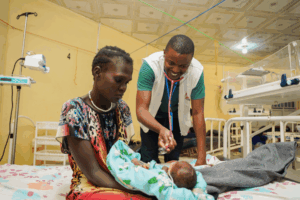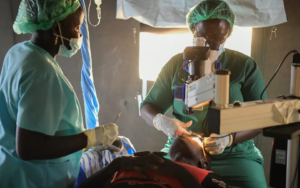For more than 30 years, physician Jill Seaman has treated infectious diseases through South Sudan Medical Relief in one of the world’s most remote and conflict-affected regions, saving thousands of lives in conditions most would consider impossible.
Dr. Jill Seaman never planned to work in Africa. “It was an accident. I never expected to go to Africa. I never even dreamt of it when I was a child,” she told her biographer. Yet for more than three decades, this Idaho-born physician has dedicated her life to treating some of the world’s most neglected diseases in southern Sudan (now South Sudan), working under conditions that would challenge even the most resourceful medical professionals.
Seaman’s humanitarian path began in 1984 when she responded to Ethiopia’s devastating famine. But it was her arrival in Sudan’s Western Upper Nile region in 1989, during the height of the civil war, that would define her life’s work. She encountered a catastrophic outbreak of visceral leishmaniasis—known locally as kala-azar—a parasitic disease spread by sand fly bites that causes fever, organ enlargement, and death without treatment.
“When I went overseas, there was a huge kala-azar epidemic. Fifty percent of the population was already dead, and the world did not even know that. It was a place where there was a lot of need,” she recalled in her biographical profile.
Working initially with Médecins sans Frontières, Seaman established makeshift clinics in areas with no electricity, running water, or healthcare infrastructure. When the organization withdrew in the late 1990s due to security concerns, Seaman made a decision that speaks to her extraordinary commitment: she stayed. She founded South Sudan Medical Relief to continue providing care during Sudan’s dry season, while spending the other half of each year delivering healthcare to Yup’ik communities in Bethel, Alaska, another remote and underserved population.
Her clinic in Old Fangak operates from a dilapidated building constructed by the British in the 1930s. Seaman often sleeps in a tent nearby. Supplies are scarce, and patients sometimes walk for days to reach treatment. Yet from this modest base, her team now treats approximately 40,000 patients annually, addressing not only leishmaniasis but also tuberculosis, malaria, hepatitis B, and other diseases.
Seaman’s approach combines medical innovation with practical adaptation to extreme circumstances. She has developed field-appropriate protocols for administering complex treatment regimens to semi-nomadic, often illiterate patients. Her research on leishmaniasis and tuberculosis in resource-limited settings has been widely published, and she has trained local health workers to extend the reach of care beyond what she alone could provide.
Her work has earned significant recognition. Time Magazine named her a “Hero of Medicine” in 1997. In 2009, she received a MacArthur Fellowship—the so-called “Genius Grant”—which she directed back into her medical projects in Sudan. Most recently, in 2025, she was named one of four Aurora Humanitarians, finalists for the $1 million Aurora Prize for Awakening Humanity.
What keeps her returning year after year? “Once that happens, and once you live through that, suddenly you end up somehow bonded to the area and the people, and that’s how come I’m still there,” Seaman explained in her profile. “I’m very fortunate to have found a place where what I’ve been trained to do can be put to good use.”
Her work exemplifies what the MacArthur Foundation described as “adapting the tools of 21st-century medicine to address the needs of those in abject poverty” and serves as “a pioneering authority on how to provide life-saving medical care in all but impossible conditions.” For the Nuer people of South Sudan and the Yup’ik communities of Alaska, Dr. Jill Seaman’s presence means access to healthcare is not determined by geography, conflict, or poverty—it is a fundamental right she works daily to uphold.
This summary is based on the following articles:
- South Sudan Medical Relief: Our Team
- MacArthur Foundation: Jill Seaman
- Global Humanitarians Shortlisted for Prestigious 2025 Aurora Prize
Watch this video about Dr. Seaman from 2009:
Related Articles

A New Home for Healing
In a shift towards sustainable healthcare in Unity State, South Sudan, Médecins Sans Frontières moves medical services to a state-owned hospital after 10 years of care.

All Eyes on Remote Uganda
At the River Kayo, Ugandan Ministry of Health and Carter Center staff are carefully monitoring the black flies that breed in its waters for evidence of the parasite that causes onchocerciasis.

South Sudan’s First Female Eye Surgeon Restores Sight to Thousands
Dr Aja Kuol, South Sudan’s first female ophthalmologist, travels to remote villages to perform life-changing eye surgeries, partnering with Mission Aviation Fellowship to reach the most isolated communities.



